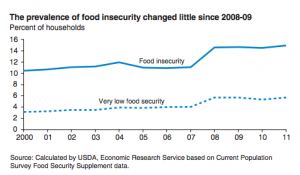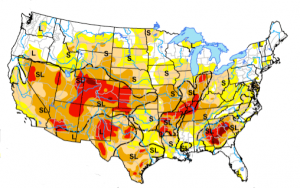What You Won’t Hear at the DNC: Children Are Going Hungry in the Richest Country in the World
 Here’s what the Secretary of Agriculture–who is in charge of our nation’s Food Stamp program–had to say about food and hunger at his DNC speech last night:
Here’s what the Secretary of Agriculture–who is in charge of our nation’s Food Stamp program–had to say about food and hunger at his DNC speech last night:
You know, rural Americans are a special people. Their labor puts food on our table and fuel in our gas tanks.
[snip]
Today, President Obama is making smart investments in clean energy—wind, solar, biofuels —as part of an all-of-the-above energy strategy that supports thousands of jobs, not in the Middle East, but in the Midwest. And in this season of severe drought, President Obama has acted to help, while calling on Congress to act as well.
For Tom Vilsack, corn is what you pour into a car, not what you put into hungry bellies, not even during a year of record drought.
And here’s what the Chair of the Senate Agriculture Committee, who is up for re-election and who is fighting with Paul Ryan’s obstructionist House Republicans over whether the Farm Bill will cut food stamps, had to say about food and hunger while she stood on the DNC stage last night:
(In other, um, words, Obama gave Debbie Stabenow no speaking role.) Even Elizabeth Warren, who gave a great speech focused on how rigged the game is against struggling families, didn’t talk about hunger. Bill Clinton got huge cheers, though, when he made clear that Obama wants to require the poor to work more for welfare, not less.
And yet this week Vilsack’s Ag Department just released the annual report on Food Insecurity showing that more action is needed. (h/t Jeff Bryant) Among other things, the report showed that the number of US households that experienced very low food security last year–6.8 million households or 5.7% of the population–went up last year to the elevated levels of 2008 and 2009. And while parents and policies usually shield children from hunger, in 374,000 homes, they weren’t able to (which remains at the level of 2010). Altogether, 17.9 million people were food insecure at some point last year.
I learned yesterday that if I were one of these 17.9 million people I’d be sunk. Rather than watch the early speeches last night (conincidentally, I came home just in time to see Vilsack), I attended a local poverty simulation as part of Hunger Action Week. We broke up into “families” and tried to get through a month making ends meet without enough money to do so; I was the single mother of 3 kids, aged 9 to 17, whose ex-husband had recently lost his job and stopped paying child support.
I found I immediately went into panic mode just figuring out how to pay for transportation to start negotiating the system (it was one thing that added up but wasn’t an obvious budget item). Read more →

